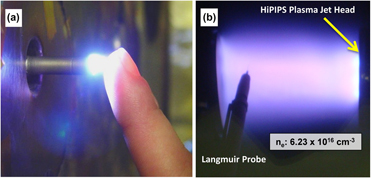Article contents
Atmospheric pressure high-power impulse plasma source for deposition of metallic coatings
Published online by Cambridge University Press: 04 June 2019
Abstract

A novel high-power impulse plasma source (HiPIPS) technology that combines atmospheric pressure plasma jets with high-power pulsed direct current generators is described. Pulsed power is applied in microsecond pulses (20 µs) at low duty cycle (10%) and low frequency (0.5 kHz) leading to high peak power densities (10–75 kW) and high peak currents (100–250 A) while maintaining low average power (<40 W) and low processing temperatures (<50 °C). These conditions result in the generation of a highly dense plasma discharge (ne = 6.23 × 1016 cm−3) for surface modification and deposition of coatings. Using HiPIPS, Ar-initiated metallic Ti, CoCr, or Ti–6Al–4V plasma was generated, and the plasma properties were characterized by measuring current–voltage characteristics, electron densities (Langmuir probe), and optical emission spectra. HiPIPS CoCr and Ti–6Al–4V coatings were deposited for proof of concept of the technique. The resulting coatings were examined with scanning electron microscopy, energy-dispersive X-ray spectroscopy, and nanoindentation.
Keywords
Information
- Type
- Invited Feature Paper
- Information
- Copyright
- Copyright © Materials Research Society 2019
Footnotes
This paper has been selected as an Invited Feature Paper.
References
- 1
- Cited by

